If you’ve spent any time on social media, you’ve no doubt seen everyone from fitness influencers and pro athletes to Fortune 500 CEOs taking selfie videos as they submerge in a cold plunge.
If your first question is a simple, “Why?”, then you’ll want to read Dr. Purita’s blog post, “7 Reasons You’ve Got to Try Our New Cold Plunge” today.
Among the benefits Dr. P lists include increased thermogenesis, accelerated recovery, reduced inflammation, mood enhancement, skin improvement and more.
But there’s one catch: you have to sit submerged in a tub of ice cold water (50 degrees or below) for a minimum of three minutes and a maximum of eight minutes if you can handle it.
And if you really want to up the anti-inflammation and longevity ante, you can pair your time in the cold plunge with an eight minute stay in an infrared sauna (120 to 140 degrees).
On their own, infrared saunas have as many health benefits as cold plunges, as you can read about in our blog here, including increased relaxation, better circulation, immune system boosts and more. However, when you combine the cold plunge with the infrared sauna, you’ve got a potent age-fighting, pain-reducing, immune-boosting regenerative medicine concoction called contrast therapy.
A typical contrast therapy session lasts about thirty minutes and includes the following rounds:
3 minutes cold plunge
7 minutes infrared sauna
Complete three rounds.
Interested? Curious what it’s like? Here’s what to expect:
When you walk into PUR-FORM’s private contrast therapy room, you’re greeted with a cold plunge tub set to a brisk 44 degrees on one side of the room and an infrared sauna set to 120 on the other side. There’s also a television on one wall if you’d like to watch sports, the news or your favorite show, giving new meaning to Netflix and chill, because with the cold plunge, you can literally do both. Ha! The cold plunge tub also has a cell phone holder if you’d like to listen to your own music or a podcast while you sit. Also, you can either wear your bathing suit to your appointment or change in the room.
It’s up to you which therapy you’d like to start with, though I chose the cold plunge because I like to do hard things first and I was sore from training for a triathlon, so the icy water was appealing.
Now for the plunge.
If you’ve never done a cold plunge before, there’s no way around the following: it’s freezing cold and it’s uncomfortable for the first minute or so.
The key to get past that initial “fight or flight” response is to focus on your breathing. I prefer the box breathing method, which is a four-second inhale, a four second breath hold, a four second exhale, a four second exhale hold, then a four-second inhale where the cycle repeats again.
This will help you slow your heart rate and blunt your stress response, which is screaming at you to get out of the cold water ASAP.
Your goal for the first plunge should be two minutes, but you’ll likely be able to get three.
Once your three minutes is up, slip on the sandals PUR-FORM provides for you and walk about ten feet to the infrared sauna.
Your legs will be icy to the touch, but you’ll feel energized and alive.
Unlike traditional saunas, the heat in an infrared sauna is generated from the infrared lights, so you won’t feel a rush of warm air or a major temperature change when you get into the infrared sauna. But you will feel relaxed and after a few minutes, your body will warm up and you’ll shake off the cold. By the time your 7 minutes are up, you may have even started sweating.
At this point, it’s time to get back into the plunge!
Now that you know what you’re in for, round two is typically much easier than round one, and most people are able to stay in the full three minutes or even choose to go four.
Whatever works for you is fine, but you’ll balance out your final two rounds between the cold plunge and the infrared sauna, aiming for three minutes in the cold and seven minutes in the heat.
Some people who are used to contrast therapy will go for two rounds, with each session being longer in each treatment. For instance, they may go five minutes in the cold plunge followed by ten in the sauna back to back.
Whatever you choose, look forward to feeling refreshed and revived after your session.
As for me, I noticed an immediate reduction in some DOMS (delayed onset muscle soreness) from my training and felt an incredible energy boost and sharpness as my body went back to baseline.
Whether you’re training for an athletic event or looking for a way to reduce everyday aches and pains, contrast therapy is just about the most effective thirty minutes you can spend to heal your body while fighting inflammation and boosting your mood, energy levels and immunity.
And you may also enjoy these features:
The Four Most Common Golf Injuries and How to Fix Them
10 Reasons You Need to Combine Aerobic and Anaerobic Exercise ASAP














